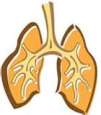
COPD Underlying Cause in 5 Percent of U.S. 2005 Deaths: CDC
Researchers from CDC's National Center for Chronic Disease Prevention and Health Promotion have concluded COPD, chronic obstructive pulmonary disease, was the underlying cause of 718,077 U.S. deaths in 2000-2005, and it was the underlying cause of about 1 in 20 U.S. deaths for 2005 alone. Their study, "Deaths From Chronic Obstructive Pulmonary Disease—United States, 2000-2005," is published in the current issue of JAMA (Vol. 301, No. 13).
Smoking is estimated to be responsible for at least 75 percent of COPD deaths, but occupational exposures to dusts, fumes, and gases are linked to about 15 percent of COPD cases. The study estimates excess health care expenditures are nearly $6,000 annually for every COPD patient in the United States.
The researchers say to decrease the number and rate of COPD deaths, public health programs should continue their efforts to reduce all personal exposure to (1) tobacco smoke, including passive smoke exposure; (2) occupational dusts and chemicals; and (3) other indoor and outdoor air pollutants linked to COPD. Once COPD is diagnosed, chronic disease management programs should work to prevent further deterioration in lung function and reduce COPD mortality, they recommend.
They found no significant change in age-related mortality rates during the period, but the death rate for men declined during 2000-2005 and was lower in 2004 than in 2005. Among women, annual deaths rose 11 percent from 2000 to 2005 and were lower in 2005 than in 2004. The death rate for women increased from 2000 to 2003, decreased in 2004, and increased in 2005. The death rate was higher for men compared with the rate for women in each year, but the number of deaths was greater for women. In 2005 among adults ages 25-64, age-standardized death rates ranged from 6.2 (Massachusetts and New Jersey) to 19.2 (Oklahoma) per 100,000 population for men and from 3.8 (New Jersey) to 16.5 (West Virginia) for women.
The findings by DW Brown, JB Croft, KJ Greenlund, and WH Giles of the Division of Adult and Community Health are subject to at least two limitations: misclassification of race in the population census and on death certificates, and errors in diagnosis and reporting on the death certificates.